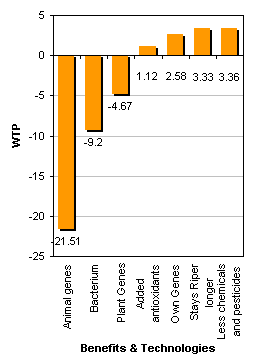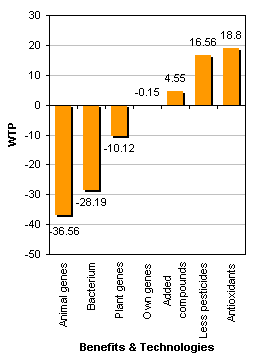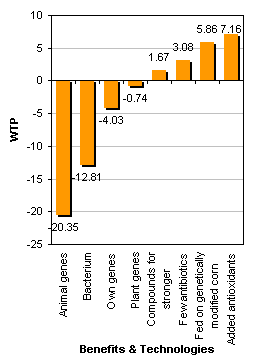The Promise of Ag-Biotech
The biotechnology industry has spent substantial money researching and developing genetically modified (GM) products with tangible consumer benefits. The potential benefits include longer shelf stability, enhanced sensory appeal, reduced allergenicity, and nutritional or wellness attributes (Riley & Hoffman, 1999; Feldman et al., 2000). It is understandable that these distinct consumer GM food products' benefits (which are not available in the non-GM products) are likely to be critically important for broad consumer acceptance. However, as GM food products with enhanced and functional attributes appear in the marketplace, consumers will be faced with the choice between GM products bringing tangible benefits (but carrying unknown risks) and the traditional non-GM products that do not provide distinct and tangible consumer benefits.
It is important that researchers contribute to the ongoing discourse over benefits and risks of biotechnology by providing scientifically credible information on how consumers value various food attributes, including process attributes such as genetic modification. This is especially true given that food consumption in the United States and other developed countries is driven by factors other than physiological need. The majority of consumers in these countries want foods that are not only safe, but also promote good health and overall well being (Senauer, 2001). This study contributes to the ongoing debate over food biotechnology by explicitly modeling how consumers trade-off the potential or perceived risks of GM foods with the possibility of extracting significant benefits from GM foods.
In particular, this study analyzes (i) how consumers value the attributes embodied in food products (e.g., production technology, product benefit); (ii) how consumer valuation of these attributes vary across product types (e.g., whether it is consumed as a fresh product, a processed product, an animal-based product); and (iii) how the preferences over product attribute and product type combinations are influenced by the consumer demographics.
Understanding the values consumers place on individual product attributes may provide insights for the food industry in tailoring targeted marketing product strategies in line with changing consumer demands. The study results may also help policy makers decide which potential benefits of genetic modification are viable and acceptable to consumers.
Data and Modeling Framework
Data used in this analysis were obtained from mail interviews of respondents recruited at the end of a national telephone survey conducted and completed between February 27, 2003 and April 1, 2003. The mail survey elicited consumers' stated preference for the GM foods.
Before fielding the choice modeling mail survey, the experimental design was subjected to several lengthy discussions by various groups, comprised of life and social scientists. This facilitated decisions on the appropriateness of products that may appeal to the larger public, with potential and likely attributes and plausible genetic modification technologies through which the products could be delivered. The products chosen were either whole (fresh), processed; or animal-based. In terms of benefits, care was taken to incorporate benefits that could broadly impact a consumer's health, have some type of consumer benefit, or provide a 'societal' benefit. While in the case of technologies, the strategy was incorporating a wide range of existing and potential technologies such as plant or animal-based genes or micro-organisms (bacterium).
Consumer preferences over food attributes are analyzed within the random utility discrete choice model framework (McFadden, 1978; Revelt and Train, 1998). Since market data from GM food products are not available, stated preferences (SP) choice modeling framework (Louviere, Hensher, & Swait, 2000) is used. The empirical model (i.e., the random parameter model) was estimated to obtain respondents' valuation of the benefits and the technologies jointly. The analysis involved examination of potential industry products in very specific details. Whose advantage was in terms of respondents' ability to relate to specific product characteristics based on carefully thought out answers. For example, corn flakes with longer shelf life versus corn flakes that stay crispy in milk longer or a banana that does not often bruise as quickly.
Consumer Stated Preferences
The willingness to pay/accept values was estimated by evaluating the ratio of the attribute coefficient (benefit or technology) to the coefficient of the monetary variable. Ceteris paribus, implicit prices were obtained that represent marginal rates of substitution between the attribute of interest (technology and benefit) and the monetary attribute. The positive values imply changes were beneficial (i.e., a consumer was willing to pay a positive amount for an increase of the attribute), while negative values implied reduction in utility (i.e., the consumer required compensation which may be in the form of a price discount for a unit increase in the attribute in this case the value may be taken to measure willingness to accept (WTA)). In reality, when consumers are presented with actual choices of GM products, stated preferences may be different from the actual buying behavior.
Figures 1-3 present the mean willingness to pay for bananas, cornflakes, and ground beef. Most of the benefits across the three products have a positive effect on choice across the three products. The exception is antioxidants in the banana and added nutrients for stronger teeth and bones in ground beef that were insignificant. The significant and positive product benefits have a welfare improving effect on a genetically modified food choice. The negative coefficients on genetic modification technology imply that moving from the conventional food production technology reduces the probability of selection as that may lead to overall reduction in a consumer's utility. Conversely, a positive coefficient on a technology leads to an increase of utility. When ground beef was a product of cows fed on GM corn and a banana was modified using its own genes, in this case technology served to enhance consumer utility. Genetic modification involving animal genes, Bacterium, and plant genes has a negative effect on choice (i.e., reduces the probability of the GM alternative being selected).
Bananas
In the case of the banana (a fresh fruit or vegetable product), positively associated benefits were: use of less pesticides and chemicals to grow bananas, and increased shelf life (i.e., a banana that stays riper longer and reduces bruising). Respondents were willing to pay about 3% more compared to the current price in order to obtain such benefits. On the other hand, in case of technology; if the banana product is a result of genetic modification via plant, animal, or bacterium genes, the respondents needed to be compensated to accept it. The results show that more compensation is required to induce acceptance of processes involving animal, bacterium, and plant genes (22%, 9%, and 5%, respectively). Conversely, if the GM banana was a result of own gene transfer, consumers were willing to pay 3% more for the product. The results also show that respondents ranked technology from least to more acceptable (i.e., moving from a small to a larger negative and vice-versa). They ranked genetic modification via own genes top, followed by plant, with bacterium and animal-based technologies at the bottom. Given the normality assumption, at the same price, about 32-35% of the respondents would have placed a negative valuation of less pesticide use, added antioxidants, and a banana that ripens longer. Unlike the benefits, respondents largely placed negative valuation on technologies, ranging from 63-84%.
Cornflakes
In case of cornflakes (a processed product), respondents valued all the benefits positively. The benefits included: less chemicals/pesticides in corn production, added antioxidants to reduce aging, and added compounds for increased energy. However, given the normal distribution assumption, about 18-40% of the respondents could have valued these benefits negatively. Results indicate that respondents were willing to pay between 5% and 19% more to obtain the direct health and environmentally related benefit of corn produced with less pesticides and chemicals. Unlike the case of benefits, respondents largely placed a negative valuation on technologies ranging from 47-81%. As a result, if the cornflakes are genetically modified using plant, bacterium and animal genes, consumers need to be compensated by about 10-37% more to accept the cornflakes.
Ground Beef
For ground beef (animal-based product), with the exception of added compounds for stronger teeth and bones which turned out to be insignificant, consumers were willing to pay 2% more to obtain the benefits of less antibiotics in cow production and 3% more for antioxidants to slow down the aging process. In contrast, consumers required a compensation to accept ground beef, which was a product of genetic modification involving animal or bacterium genes (20% and 13%, respectively). However, if the ground beef was a product of a cow fed on GM corn, consumers were willing to pay 6% more. With the normality assumption, at the same price, about 52-62% of the respondents placed a positive valuation on fewer antibiotics and antioxidants. On the other hand, compared to cornflakes and bananas, fewer respondents placed a positive coefficient on technology ranging from 19-60%.
Implications for Food Industry
The study results show that the use of choice modeling experiments provides a way of valuing non monetary attributes associated with consumption of GM food products and a way of identifying consumer preferences. The results indicate how different attributes of price, product benefits, and technology influence consumer demand for genetically modified food products. The results show how a consumer makes tradeoffs between the product attributes.
The results suggest that across the products, direct health, environmental and production-related benefits have a positive effect on choice. Also, the results generally show that genetic modification is viewed negatively. However, through the choice modeling experiments, respondents viewed own- and plant-based genetic modification less negatively than the use of bacterium and animal-based genetic modification. These results may suggest that attitudes may be somehow more promising for GM processes involving own- or plant-based gene technology. Respondents' willingness to pay for benefits embedded in the products suggests that there is potential for GM foods in the market.
Understanding the values consumers place on individual attributes can provide insights for the food industry in tailoring targeted marketing product strategies in line with changing consumer demands. The study results also provide information to policy makers on which direction to go in terms of genetic modification (i.e., what is viable and acceptable).
For More Information
Feldman, M.P., Morris, M.L. & Hoisington, D. (2000). Genetically Modified Organisms: Why All the Controversy? Choices (First Quarter), 8-12.
Louviere, J., Hensher, D. & Swait, J. (2000). Stated Choice Methods: Analysis and Application. Cambridge, University Press.
McFadden, D. (1978). Modeling the choice of residential location. In A. Karlqvist, L. Lundqvist, F. Snickars, and J. Weibull (Eds.). Spatial Interaction Theory and Planning Models. Amsterdam: North Holland, 75-96.
Revelt, D., & Train, K. (1998). Mixed Logit with repeated choices. Review of Economics and Statistics, 80, 647-657.
Riley, P., & Hoffman, L. (March 1999). Value-enhanced crops: Biotechnology's next stage. Agricultural Outlook, 18-23.
Senauer, B. (2001). The Food Consumer in the 21st Century: New Research Perspectives. Paper presented at the 71st EAAE Seminar: The Food Consumer in the 21st Century, April 18-20, Zaragoza, Spain.
|
|
Other articles in this theme:
|
|



